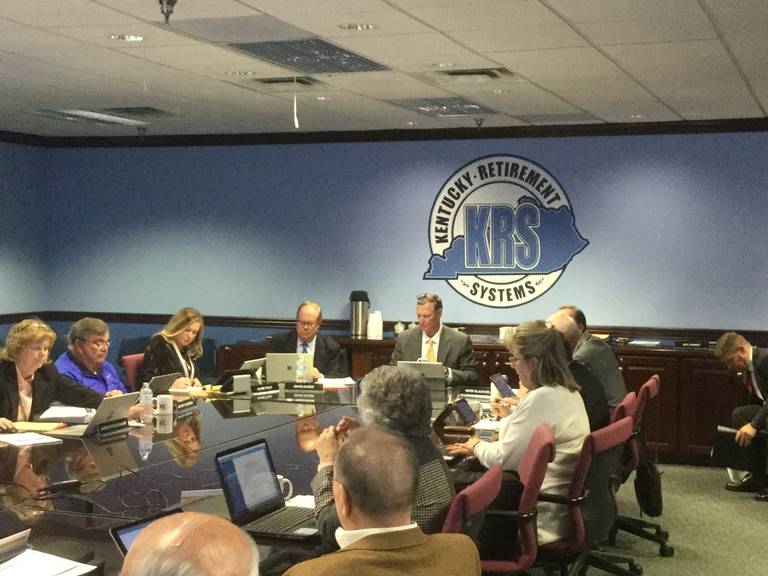
By John Cheves
Click here to view the full article
Nurses of the Garrard County Health Center voice concern about keeping their pensions in light of a new pension law that provided incentives for quasi-governmental entities to exist the state pension system. BY MARCUS DORSEY
Gov. Matt Bevin and the General Assembly have diverted hundreds of millions of tax dollars into Kentucky’s ailing state government pension system since Fiscal Year 2017 to restore it for the future. But its funding level — the money it has compared to the money it’s expected to need — kept dropping, down to 12.9 percent last year.
On Thursday, the Kentucky Retirement Systems Board of Trustees finally heard some good news: The state pension system nudged upward in 2019 to 13.4 percent funded. While it’s still probably the weakest public pension system in the country, that was its first increase after two decades of decline.
That’s a big deal, KRS officials said after their briefing by actuarial advisers from GRS Retirement Consulting.
“From what we can see, we’ve hit the bottom,” said David Eager, KRS executive director. “As long as we keep getting the ARC (the actuarial recommended contribution), we’ve hit the bottom, absolutely.”
This year, Kentucky is spending $1 billion of its $11 billion General Fund on state pensions, based on a contribution rate of 85 percent of state payroll. The actuarial advisers said Thursday that the state’s contribution rate should rise to 93 percent in the next budget.
Unless Beshear, a Democrat, and the Republican-led legislature can agree on new revenue sources, such as casino gambling, everything else the state funds — schools, universities, health care, social services, prisons, roads — will be squeezed even tighter in order to find enough money for the higher contribution rate.
Part of the reason for the higher rate is a more conservative assumption the KRS board adopted this year about life expectancy. Kentucky’s public employees are living longer in retirement — on average, about a year longer than they worked for the state and paid into the pension system. That means even more money must be set aside for them.
“The answer,” said KRS board chairman David Harris, “is to increase —”
“Revenue,” interjected Eager.
“Economic activity in Kentucky, which increases revenues, which increases the number of people moving into our state. That’s ultimately got to be what happens,” Harris said.
KRS is responsible for providing pension and medical benefits for several hundred thousand active and retired public employees in Kentucky. It’s divided into three separate pension systems: KERS for state government employees, the State Police Retirement System for Kentucky State Police and the County Employees Retirement System for local government employees.
Within KERS and CERS, there are separate pension funds for employees with non-hazardous and hazardous jobs.
Overall, KRS on June 30 had $12.5 billion in pension assets and $25.8 billion in unfunded pension liabilities, up $2.2 billion from $23.6 billion in unfunded pension liabilities one year earlier. That means KRS in total has a 33 percent funding level for its pensions.
Unfunded pension liabilities grew because funding levels dropped a bit this year in most of the pension systems managed by KRS other than KERS (Non Hazardous), due to the new life expectancy assumption and more lenient payments allowed for some local government employers, KRS officials said.
Among the agency’s individual plans, KERS (Hazardous) was funded at 54.8 percent, compared to 55.5 percent last year; CERS (Non-Hazardous) was funded at 49.1 percent, compared to 52.7 percent last year; CERS (Hazardous) was funded at 45.3 percent, compared to 48.4 percent last year; and SPRS was funded at 27 percent, compared to 27.1 percent last year.
KRS is in such woeful shape because of many years of inadequate contributions by state leaders and unreasonable expectations about investment returns and payroll growth.
The legislature passed a bill this summer that will allow some quasi-public employers, such as regional universities, county health departments and community mental health nonprofits, essentially to buy their way out of the pension system and avoid future contribution hikes.
KRS is still working on the regulations that will be necessary for the quasi-public employers to withdraw from the pension system through this legislation. But rank-and-file workers at some of these agencies have expressed alarm at the prospect of having their state pensions frozen in the middle of their careers and replaced with a less generous defined-contribution account.
Some of the demographics of the state pension system are proving difficult to navigate, GRS Retirement Consulting advisers said Thursday.
For example, the number of retirees drawing a check from the state pension system is ever-rising, up to 47,430 this year, while the number of active workers contributing to the system with every paycheck continues to fall, down to 33,696 this year. On top of that, state salaries have been effectively flat for many years, with pay raises but a distant memory, and contributions to the pension system are based on a percentage of payroll, the advisers said.
Kentucky Personnel Secretary Thomas Stephens, who sits on the KRS board, confirmed this to his colleagues. Stephens said that at the start of then-Gov. Ernie Fletcher’s administration in 2004, there were a little more than 40,000 people working for Kentucky state government’s executive branch. Today, it’s about 29,300, he said.
“In the executive branch, we are right-sizing job positions,” Stephens said. “There is no foreseeable increase coming in state employment.”